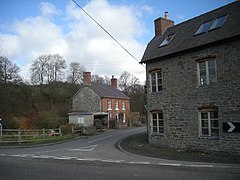New Invention, Shropshire
| New Invention | |
|---|---|
 Houses at New Invention |
|
| New Invention shown within Shropshire | |
| OS grid reference | SO293766 |
| Civil parish | |
| Unitary authority | |
| Ceremonial county | |
| Region | |
| Country | England |
| Sovereign state | United Kingdom |
| Post town | BUCKNELL |
| Postcode district | SY7 |
| Dialling code | 01547 |
| Police | West Mercia |
| Fire | Shropshire |
| Ambulance | West Midlands |
| EU Parliament | West Midlands |
| UK Parliament | |
New Invention is a hamlet in Shropshire, England on the A488 between Clun and Knighton. It comprises little more than four houses around a cross-roads and a neighbouring farm called The Weir, known in history as the Wear or Ware. Of the four houses, one was a blacksmith's shop, one a pub called the Stag's Head, and one a Methodist chapel built in 1874. It served as one of many local locations for the film Gone to Earth (released 1950), directed by Michael Powell and Emeric Pressburger. The River Redlake passes through. The population as of the 2011 census is listed under Clun.
There is a story that the hamlet's unusual name came from a local farrier who decided on the idea of fitting horseshoes backwards to confuse the enemy in times of war. A variation of this story is that the farrier reversed the shoes on the horse belonging to Charles I to help him evade capture. A slightly more credible explanation is that the village was the first in the district where spinning was carried out using water power, but this theory can almost certainly be discredited by the fact that the earliest known reference to New Invention is in a document held at Shropshire Archives dated 1677 (ref 2589/D/108), while machinery for carding and spinning wool was not invented until well into the 18th century. Fulling mills, which cleaned and thickened wool, were powered by water in medieval times, and there are records of at least two in Clun, so this possibility can not be entirely discounted.
Better explanations may be found by considering the separate elements of the name. 'New Inn' within a place name is often a modern prefix to an older name. If that applies here, then the meaning of 'Vention' has to be explained. The first clue is that local people refer to the hamlet as 'The Vention', a nomenclature that could be older than the present name. The second clue is that many place names in the Redlake Valley, in which New Invention lies, are of Old English (Saxon) origin, and 'Vention' could have its origins in 'Fenton' or 'Fentone', a not uncommon place name meaning 'settlement in a marshy place'. New Invention is low-lying between hills and a river runs through it. In the Middle Ages Welsh was the predominant language. 'F' in Welsh is pronounced 'V'. If correct, its name means a 'new inn at a settlement in a marshy place'. Further support for the mutation of the 'F' to 'V' can be found from Venn Ottery in Devon, where the V from the earlier 'Fenne' (also meaning a marshy place)is a function of dialect, which is just as possible in Shropshire as is its being a function of language.
...
Wikipedia

